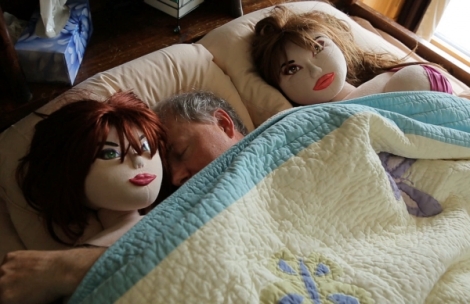
Maureen Judge is an award-winning writer, producer and documentarian. Her most recent film, Living Dolls, follows five doll collectors at various levels of interest and obsession. Living Dolls had its World Premiere at the 2013 Austin Film Festival, where it was nominated for Best Documentary Feature. Additionally, it premiered on American television on Logo TV in November 2013 and is now available On Demand. On February 17, 2014, the film will have its Montana premiere at the Big Sky Documentary Film Festival. Maureen Judge spoke with Sean Malin of CineMalin: Film Commentary and Criticism about the taboos of doll collecting, opting for lighthearted tones over somber ones, and the all-seeing power of the documentary camera. This interview has been transcribed, edited, and compressed from audio for publication.
*****
Sean Malin: Your newest film was partly financed by the Canadian government. How did that come to pass – did they come to you or did you go to them?
Maureen Judge: I tend to work with public television a lot – TV Ontario, the CBC, National Film Board of Canada – and usually I go around with an idea of my own. But this one was done with a commercial station called Global Television, who met with me and told me they wanted to do a show on their program Close Up that deals with people who are part of sub-cultures. “Would I be interested in pitching something like that?”
SM: And what they were asking you to pitch was not unfamiliar territory.
MJ: No, this is exactly what I like to work with and the idea came pretty quickly. My previous work deals with relationships and is character-oriented or subjected-oriented, and often it’s around women, whether mothers and daughters, or adult kids coming home to live with their parents. Many of the women in my previous films had been doll collectors, and I was fascinated by it. In my last film [Mom’s Home, 2010], which dealt with elderly mothers moving back in with their middle-aged daughters, one woman was moving to Scotland with her daughter because she had Alzheimer’s. The mother had to give away her dolls, all of which had personal histories, and it was like giving away her life’s memories. So for Living Dolls, I looked for people who had strong relationships with their dolls, rather than just huge collections. I wanted to ask what the dolls do for people, and how they affect other parts of their lives.
SM: You started out making cinema verite. How much of that style has been in your recent work?
MJ: Mom’s Home has a strong verite feel, but not as much in this film. Living Dolls has more music than ever, a great score by Aaron Davis that opens up a lot of space for thought. Because I didn’t want to judge the subjects on screen, we wanted music that didn’t pull too many strings…literally.
SM: *Laughs* The subjects of your film live all over – Canada, U.S., and England. What was the search for these collectors like?
MJ: This is the first film I’ve ever done where about 95% of all my research was done online.
SM: If your experience online is anything like mine, that must have been a rabbit hole of research: down, down, down…
MJ: It was extremely interesting; we got hundreds of responses on Facebook. The doll collecting business is almost completely online at this point, which is exactly why the collectors are online. And they’re in their own groups, too – the Barbie doll lovers buy the Barbie dolls, the Ellowynes are with the Ellowynes. So we’d join the individual groups, ask if we could put out a little message about doing this documentary, and they were overwhelmingly receptive. People would just come to us and recommend themselves or other people they knew. We also found Mike Meireles [who appears in the film] on a local Craigslist-type site.

SM: Did all of the subjects approach you after those messages?
MJ: All except Michael Sullivan, whom I had read an article about online at some point in research. There was a film called The Meaning of Robots (2010, Matt Lenski) about Michael, who’s been making this animated sex film for years, that played at the Sundance Film Festival in 2012. So I e-mailed the writer of the article to ask for Michael’s contact information, they gave me his e-mail soon after, and when I e-mailed [Michael], lo and behold, I got a response maybe a minute later!
I thought he was so amazing that I included him in the demo – he’s very eccentric, he’s an artist, he’s in a forty-two-year relationship with his partner Trix…He’s loved by people. And he liked Living Dolls so much he sent me a handmade robot with turquoise eyes! What’s so unique about Michael is that he makes his robot dolls from discarded Barbies rather than collecting them. For Mike, the Barbie collector, he wants [his dolls] to look like Barbie, but for Michael, they’re armatures – he uses the Barbie as a framework to build his work on. It’s almost ironic considering how weird the actual Barbie figure looks that he makes sex robots from them.
SM: Michael’s robot dolls are truly beautiful. They remind me of those dystopic dolls from Shane Acker’s 9 (2009), but like those robots, Michael’s walk a fine line between creepiness or dangerous, and eccentricity and beauty. I have to wonder if there were any more seriously strange or “eccentric” subjects that you felt would not fit in your film.
MJ: Not really, but in some more eccentric cases we ran out of time. For example there was a get-together of “reborn doll” collectors when I was in England, but we wanted to spend more time shooting with [film subject] Debbie. Debbie really loves Ellowyne dolls, which have a kind of adolescent figure – budding breasts, etc. She never had much of an adolescent because she got pregnant when she was a teenager and married her husband, Colin. Debbie is able to reclaim that kind of adolescent innocence in the dolls she collects. These dolls are sort of made in our likeness and we can project a lot of our desires and needs onto them. We can share our secrets with them.
SM: So are re-born dolls like Christ-figures?
MJ: No – they look like real babies. You think they’re real children when you see them. I shot with them for about a day. But in the end we stuck with the real-looking, life-sized silicon dolls that David collects in California.
SM: Were the peripheral family members or close friends – for example, Mike’s lover Anibal or Debbie’s husband Colin – shy or reticent to appear on camera given the subject matter?
MJ: As you can see from their appearances in the film, almost all of them wanted to share the screen with the exception of David’s family. Anibal in particular was really excited for Mike and wanted to celebrate his Barbies, so he was very into it. Mike’s mother is also his best friend, so she was excited, too, whereas his father didn’t want to appear on camera but was more than happy to let us shoot in their home. Same with Debbie – Colin wanted to do it because he hoped it could be a learning process for both of them. And he was so natural on camera that I thought he, of all the people [in the film], could most have considered narrative acting.
SM: In a character-oriented film like this, there’s a thin line between authenticity and play-acting. How different were the subjects on camera versus off?
MJ: After you spend some time with people, they tend to start being pretty close on camera to what they’re like off it. Mike really enjoyed performing for the camera at first, but then when we go with him to Los Angeles, you see his depth come through. It was a surprise to me, too, and it was so heavy. Colin and Debbie were about the same – so natural, too. David loved the camera, but he was hyper on and off screen *laughs*.

SM: Barbie, Ellowyne, and David’s Cover Doll magazine business are all major industry players in the doll collector world. Did any of the corporations have qualms about your representing their products onscreen? I ask because some of these subjects – David’s love doll collections, for example – are still fairly taboo. I can imagine corporate lawyers saying, “Feel free to use the Barbie Convention in your film, but don’t portray it in a negative fashion.”
MJ: David is a co-owner of Cover Doll and he was so proud to see it onscreen. That’s his “real doll” business – I’m sure he was happy to promote it, though I focus much more on his relationships. He even reached out to us to express interest in the film, so no trouble with representing his company. Mattel, who owns Barbie and was very nice to us, doesn’t actually put on the convention; it’s the National Barbie Doll Collectors, and two of their PR people were with my crew the whole time we filmed at the Convention. They didn’t ask to see the footage or demand a look at it or anything, though.
SM: You World Premiered Living Dolls at the 2013 Austin Film Festival, and it was also seen on Canadian television. Have you observed any differences in how the regional audiences respond to the film?
MJ: *Laughs* Actually, what’s so crazy is that the response has been great across the board. The audiences relate to these people…not because they collect dolls or love Ellowyne, but because everybody has dreams and obsessions. What I think makes the subject taboo is that people think of dolls as child’s play. But grownups who don’t play with dolls still have this sense of fantasy within.


Pingback: Living Dolls Interview with maureen Judge in CINEMALIN: FILM COMMENTARY & CRITICISM | makin' movies·